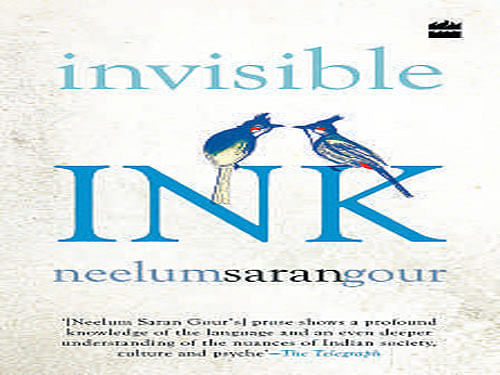
A journey of two friends amidst familial, social, and religious vicissitudes is the focus of Neelum Saran Gour’s latest book, Invisible Ink. Set in Gour’s favourite location, Allahabad, the novel courses through the lives of two friends, Rekha and Amina. Living in Bulbul Kothi, the girls not only share their childhood days of playing with dolls, but also the bitter-sweet pangs of adolescence and growing up as adults.
Narrated by Rekha, the story begins in the present at a time when both friends meet after ages. Gour’s tale intertwines the past and the present, bringing forth remembrance of the earlier days when things were simpler and untouched by contemporary social and religious complexities. Relying heavily on the bygone days, the book captures the narrator’s journey of life as the daughter of a single mother, deserted by her husband for another woman.
The story continuously moves from the present to the past as Rekha recollects her childhood days, her mother, the traditional way of her upbringing, and her brief love affair with Danish-bhai which ended in much humiliation, bitterness, and heartbreak. Each character in the book comes alive with Rekha’s interpretation and commentary of their lifestyle, bringing out the traditional Lucknowi culture.
Gour’s book relies heavily on human equations, and the narrator with her connection to the other characters provides the readers with glimpses of the traditional set-up of life in Bulbul Kothi. Influenced by Hindi films and the normal wish of adolescence to look desirable, Rekha and Amina, cloaked in burqas, visit a salon to get transformed.
However, growing up as teenage girls, they are secluded from the modern world to such an extent that a visit to a beauty parlour causes tremendous upheaval in both the families and the new looks are compared to styles fashioned by lowly women. Rekha’s initiation into puberty is equally appalling for her, with no prior knowledge and guidance on the same.
With a great sense of humour, Gour deals with the girl’s confusion of menstrual blood with pregnancy and childbirth, revealing the Indian scenario even in contemporary times when many parents are still not comfortable in educating their children on the process of physical changes in puberty and sexual reproduction. Rekha’s mother too concludes her maternal duties just by reprimanding the girl’s sudden bodily changes and administering decency by introducing an appropriate undergarment to make her “these things” look modest.
Invisible Ink is remarkable in its portrayal of the Indian politics of religious dissent, communal tension and terrorism in a subtle manner. Interweaved with Rekha’s narration of her childhood days and her relationship with Amina, Danish-bhai, and Mehru Apa, is the heightened religious tension in the city. Whereas Rekha’s narrative of the past is untouched by such feud, the present offers hardly a similar utopian environment. Living next to each other, Rekha and Amina had never felt the shackles of religious differences dawning on them. When Rekha’s budding relationship with Danish-bhai, Amina’s cousin, is revealed in an embarrassing situation and tackled in a severe way by both the families, it is because of the breach of traditional moral codes of conduct and not merely due to religious differences. Gour has beautifully juxtaposed communal tension and terrorism in the book.
If the past was untouched by various barriers, the present definitely offers no such respite. The concluding part of the book brings out the religious intolerance which has seeped into the society. Amina is not accepted anymore as a part of the locality and her wish to buy a property in the area remains unfulfilled. Gour includes a passing reference on issues related to terrorism too towards the end of Amina’s story and highlights how, with the passage of time, individuals and relationships have altered irrevocably. Invisible Ink, with its subtle humour, contemporary issues, and interesting narration, goes well with the readers and may trigger in some the interest to look up Gour’s other books.
INVISIBLE INK by Neelum Saran Gour
Harper Collins 2015, pp 224 299